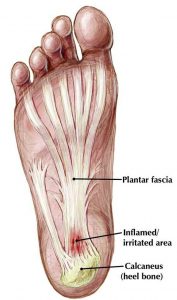
What is Plantar Fasciitis?
Plantar Fasciitis (PF) is one of the most common causes of heel pain in adults around the world with women aged between 40 and 60 most likely to contract the condition.
PF has an Incidence rate of between 10% and 20% of all athletes sustaining injury, with recreational and elite runners being the most common athlete type 4.5-10%. PF is the 3rd most common injury sustained behind Medial tibial stress syndrome and Achilles tendinopathy.
In the majority of cases, PF has been found to resolve spontaneously helping lead the theory of some studies that it is a self-limiting condition, however, there is still 5-10% of people that will end up getting surgery at some stage.
PF typically presents with pain at the fascial enthesis on the medial calcaneal tubercle (or your heel) with pain coursing distally along with the PF into the Medial Longitudinal Arch (MLA).
Whilst imaging can help rule out other differential diagnoses, the diagnosis of PF is generally clinical. Pain is often felt first thing in the morning or after a long period of rest, with the intensity of pain subsiding throughout periods of weight-bearing being either unilateral or bilateral.

Anatomy of the Plantar Fascia
The plantar fascia is a strong band of connective tissue originating at the medial calcaneal tuberosity coursing distally through the plantar foot and attaching to the plantar plates at the heads of the 5 metatarsals bones.
It consists of 3 separate bands, medial central and lateral.
These 3 bands support the MLA and during the toe-off phase of gait with dorsiflexion of the 1st metatarsophalangeal joint, create the windlass mechanism.
This tightens the plantar fascia allowing the foot to become a rigid lever for effective toe-off and propulsion to occur at the end of the gait cycle.
Studies have shown a relationship between the plantar fascia and the Achilles tendon with the continuation of the fibers from the PF uniting with the Achilles at its insertion on the posterior calcaneus.
Aetiology of Plantar Fasciitis
There are a number of contributing factors that can lead to PF and can be both intrinsic and extrinsic in nature.
Some of these include:

Initially PF was thought to be an inflammatory condition, however, studies show that the condition is not inflammatory in nature rather a mechanical overload/ degenerative condition in which the term Plantar Fasciosis would be more correct.
This degeneration is evident at the site of the PF attachment on the calcaneus and resembles something more similar to chronic tendinopathy.
Although any of the risk factors in table 1 can contribute to PF, Pes Planus foot type with increased Subtalar joint pronation have been shown to be the most significant contributing factor to the development of PF.
When taking into account the biomechanics of running it is easily understood that due to the 2-3 times body weight that is put through the plantar fascia during a run, any degenerative changes to the plantar fascia will be subject to this repetitive increase in ground reaction force each step.
Treatment
Approximately 80% of patients suffering from PF get full resolution of pain after 12 months of non-operative treatment. These conservative treatment options can include.
- Non-steroidal anti-inflammatory drugs
- Activity modification
- Stretching and strengthening exercise
- In shoe padding and strapping, gel insert.
- Foot orthoses custom or prefabricated
- Dry needling/ soft tissue massage
- Shockwave therapy
- Footwear recommendations based on patient needs
- Referral to other health professionals for help with any core issues.
There are some patients that don’t respond to this conservative treatment. Surgical treatment may be required if PF symptoms persist for 6-12 months.
The full resolution can in some cases take up to 18-24 months with a plantar fascia tear/rupture a possible outcome if activity load is not managed over this time.
Written By Podiatrist, Thomas Abraham
Areas Treated: Foot, Ankle, Knee, Toenail Care
Tom graduated from the Queensland University of Technology with a Bachelor of Podiatry. Since leaving university he has gained an interest in sports injuries, biomechanics and wound care and is always looking to learn more allowing him to provide the best treatment he can. Tom has also spent some time working with running footwear specifically ASICS.
During school and university, Tom was actively involved in playing soccer, tennis and completed in athletics up to a state-level on a few occasions. Tom is a keen traveller spending a year in Europe and some time in Nepal volunteering and completing the Everest base camp trek. Tom also enjoys snowboarding when he can.
Tom is available for Podiatry appointments at our Chermside, North Lakes and Redcliffe locations.

